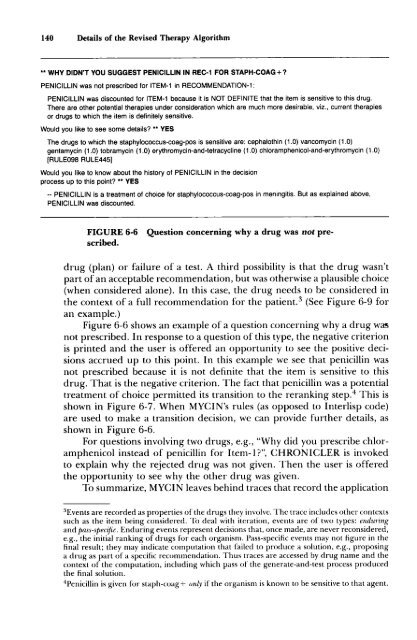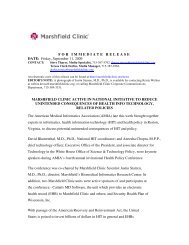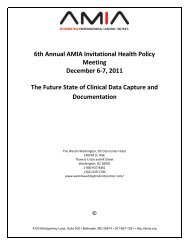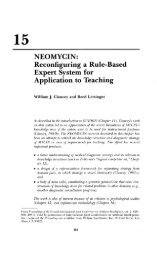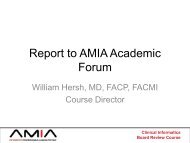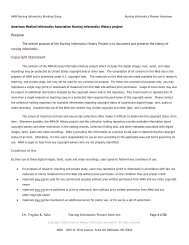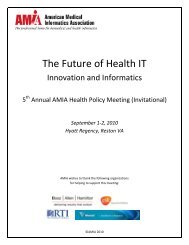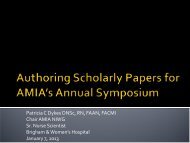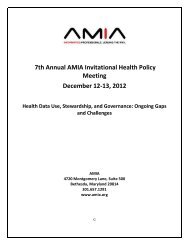Rule-Based Expert Systems: The MYCIN Experiments of ... - AITopics
Rule-Based Expert Systems: The MYCIN Experiments of ... - AITopics
Rule-Based Expert Systems: The MYCIN Experiments of ... - AITopics
You also want an ePaper? Increase the reach of your titles
YUMPU automatically turns print PDFs into web optimized ePapers that Google loves.
140 Details <strong>of</strong> the Revised <strong>The</strong>rapy Algorithm** WHY DIDN’T YOU SUGGEST PENICILLIN IN REC-1 FOR STAPH-COAG+?PENICILLIN was not prescribed for ITEM-1 in RECOMMENDATION-1 :PENICILLIN was discounted for ITEM-1 because it is NOT DEFINITE that the item is sensitive to this drug.<strong>The</strong>re are other potential therapies under consideration which are much more desirable, viz., current therapiesor drugs to which the item is definitely sensitive.Would you like to see some details? ** YES<strong>The</strong> drugs to which the staphylococcus-coag-pos is sensitive are: cephalothin (1.0) vancomycin (1.0)gentamycin (1.0) tobramycin (1.0) erythromycin-and-tetracycline (1.0) chloramphenicol-and-erythromycin(1.0)[RULE098 RULE445]Would you like to know about the history <strong>of</strong> PENICILLIN in the decisionprocess up to this point? ** YES-- PENICILLIN is a treatment <strong>of</strong> choice for staphylococcus-coag-pos in meningitis. But as explained above,PENICILLIN was discounted.FIGURE 6-6 Question concerning why a drug was not prescribed.drug (plan) or failure <strong>of</strong> a test. A third possibility is that the drug wasn’tpart <strong>of</strong> an acceptable recommendation, but was otherwise a plausible choice(when considered alone). In this case, the drug needs to be consideredthe context <strong>of</strong> a full recommendation for the patient. 3 (See Figure 6-9 foran example.)Figure 6-6 shows an example <strong>of</strong> a question concerning why a drug wasnot prescribed. In response to a question <strong>of</strong> this type, the negative criterionis printed and the user is <strong>of</strong>fered an opportunity to see the positive decisionsaccrued up to this point. In this example we see that penicillin wasnot prescribed because it is not definite that the item is sensitive to thisdrug. That is the negative criterion. <strong>The</strong> fact that penicillin was a potentialtreatment <strong>of</strong> choice permitted its transition to the reranking step. 4 This isshown in Figure 6-7. When <strong>MYCIN</strong>’s rules (as opposed to Interlisp code)are used to make a transition decision, we can provide further details, asshown in Figure 6-6.For questions involving two drugs, e.g., "Why did you prescribe chloramphenicolinstead <strong>of</strong> penicillin for Item-l?", CHRONICLER is invokedto explain why the rejected drug was not given. <strong>The</strong>n the user is <strong>of</strong>feredthe opportunity to see why the other drug was given.To summarize, <strong>MYCIN</strong> leaves behind traces that record the application3Events are recorded as properties <strong>of</strong> the drugs they involve. <strong>The</strong> trace includes other contextssuch as the item being considered. To deal with iteration, events are <strong>of</strong> two types: enduringand pass-specific. Enduring events represent decisions that, once made, are never reconsidered,e.g., the initial ranking <strong>of</strong> drugs tbr each organism. Pass-specific events may not figure in thefinal result; they may indicate computation that ~ailed to produce a solution, e.g., proposinga drug as part <strong>of</strong> a specific recommendation. Thus traces are accessed by drug name and thecontext <strong>of</strong> the computation, including which pass <strong>of</strong> the generate-and-test process producedthe final solution.4penicillin is given for staph-coag + only if the organism is known to be sensitive to that agent.


